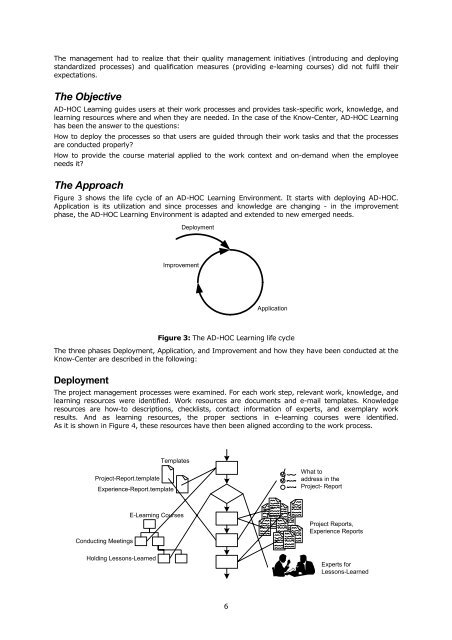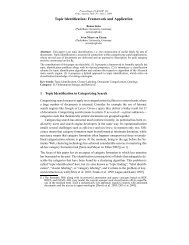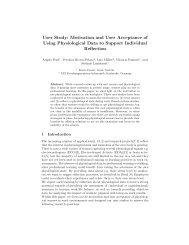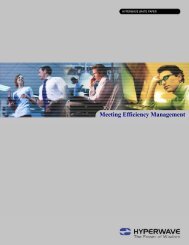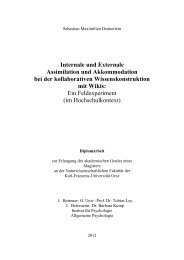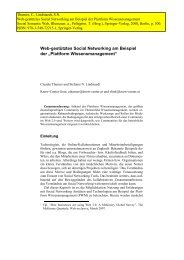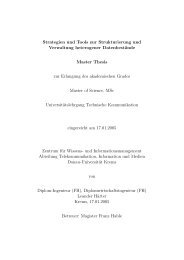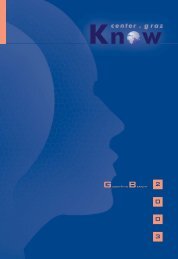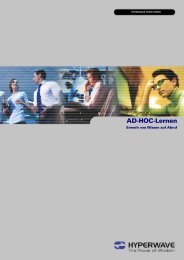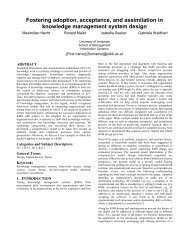AD-HOC Learning - Acquiring Skills on Demand - Know-Center
AD-HOC Learning - Acquiring Skills on Demand - Know-Center
AD-HOC Learning - Acquiring Skills on Demand - Know-Center
You also want an ePaper? Increase the reach of your titles
YUMPU automatically turns print PDFs into web optimized ePapers that Google loves.
The management had to realize that their quality management initiatives (introducing and deploying<br />
standardized processes) and qualificati<strong>on</strong> measures (providing e-learning courses) did not fulfil their<br />
expectati<strong>on</strong>s.<br />
The Objective<br />
<str<strong>on</strong>g>AD</str<strong>on</strong>g>-<str<strong>on</strong>g>HOC</str<strong>on</strong>g> <str<strong>on</strong>g>Learning</str<strong>on</strong>g> guides users at their work processes and provides task-specific work, knowledge, and<br />
learning resources where and when they are needed. In the case of the <strong>Know</strong>-<strong>Center</strong>, <str<strong>on</strong>g>AD</str<strong>on</strong>g>-<str<strong>on</strong>g>HOC</str<strong>on</strong>g> <str<strong>on</strong>g>Learning</str<strong>on</strong>g><br />
has been the answer to the questi<strong>on</strong>s:<br />
How to deploy the processes so that users are guided through their work tasks and that the processes<br />
are c<strong>on</strong>ducted properly?<br />
How to provide the course material applied to the work c<strong>on</strong>text and <strong>on</strong>-demand when the employee<br />
needs it?<br />
The Approach<br />
Figure 3 shows the life cycle of an <str<strong>on</strong>g>AD</str<strong>on</strong>g>-<str<strong>on</strong>g>HOC</str<strong>on</strong>g> <str<strong>on</strong>g>Learning</str<strong>on</strong>g> Envir<strong>on</strong>ment. It starts with deploying <str<strong>on</strong>g>AD</str<strong>on</strong>g>-<str<strong>on</strong>g>HOC</str<strong>on</strong>g>.<br />
Applicati<strong>on</strong> is its utilizati<strong>on</strong> and since processes and knowledge are changing - in the improvement<br />
phase, the <str<strong>on</strong>g>AD</str<strong>on</strong>g>-<str<strong>on</strong>g>HOC</str<strong>on</strong>g> <str<strong>on</strong>g>Learning</str<strong>on</strong>g> Envir<strong>on</strong>ment is adapted and extended to new emerged needs.<br />
Deployment<br />
Improvement<br />
6<br />
Applicati<strong>on</strong><br />
Figure 3: The <str<strong>on</strong>g>AD</str<strong>on</strong>g>-<str<strong>on</strong>g>HOC</str<strong>on</strong>g> <str<strong>on</strong>g>Learning</str<strong>on</strong>g> life cycle<br />
The three phases Deployment, Applicati<strong>on</strong>, and Improvement and how they have been c<strong>on</strong>ducted at the<br />
<strong>Know</strong>-<strong>Center</strong> are described in the following:<br />
Deployment<br />
The project management processes were examined. For each work step, relevant work, knowledge, and<br />
learning resources were identified. Work resources are documents and e-mail templates. <strong>Know</strong>ledge<br />
resources are how-to descripti<strong>on</strong>s, checklists, c<strong>on</strong>tact informati<strong>on</strong> of experts, and exemplary work<br />
results. And as learning resources, the proper secti<strong>on</strong>s in e-learning courses were identified.<br />
As it is shown in Figure 4, these resources have then been aligned according to the work process.<br />
Project-Report.template<br />
Experience-Report.template<br />
C<strong>on</strong>ducting Meetings<br />
Templates<br />
E-<str<strong>on</strong>g>Learning</str<strong>on</strong>g> Courses<br />
Holding Less<strong>on</strong>s-Learned<br />
What to<br />
address in the<br />
Project- Report<br />
Project Reports,<br />
Experience Reports<br />
Experts for<br />
Less<strong>on</strong>s-Learned


